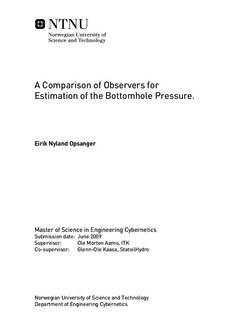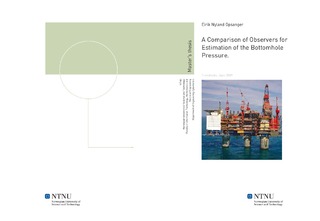| dc.contributor.advisor | Aamo, Ole Morten | nb_NO |
| dc.contributor.advisor | Kaasa, Glenn-Ole | nb_NO |
| dc.contributor.author | Opsanger, Eirik Nyland | nb_NO |
| dc.date.accessioned | 2014-12-19T14:01:51Z | |
| dc.date.available | 2014-12-19T14:01:51Z | |
| dc.date.created | 2010-09-03 | nb_NO |
| dc.date.issued | 2009 | nb_NO |
| dc.identifier | 347742 | nb_NO |
| dc.identifier | ntnudaim:4455 | nb_NO |
| dc.identifier.uri | http://hdl.handle.net/11250/259732 | |
| dc.description.abstract | New offshore oil recourses that are developed are more difficult to drill and increase the requirements to the technology in the offshore industry. A relatively new technology is Managed Pressure Drilling where a choke topside is used to control the bottom hole pressure. The bottom hole pressure measurement is unreliable, which motivates the need for an observer. Different methods for estimation will be presented and compared in this thesis. Proofs of convergence are outlined for the Stamnes observer, derived for the Grip observer and some stepping stones for further work are presented for the Optimal Polynomial Filter. Each observer is simulated with a simple step in the mud pump to verify the estimation laws. The results show that all observes estimated the bottom hole pressure correctly for this simple case. A more realistic case, a pipe connection, is also simulated for each observer. The case includes zero flow from the mud pump, which reveals that all observers miss the estimation convergence in this case, but that the estimate converges when there is flow from the mud pump. One of the states that affects the bottom hole pressure is the pressure loss due to friction in drill string and annulus. Earlier work modeled these losses as quadratic with respect to the flow through the bit, which are simplifications. To improve the estimate of the bottom hole pressure, new and better friction models are needed. Measurement data from Gullfaks C are analyzed to get new knowledge of friction loss in the drilling string and annulus. For the drill string the quadratic friction model is found to be good enough, catching the main behavior. On the other hand, the friction loss in the annulus is a more complicated function of flow. The annulus friction is approximated with sets of basis functions and the weighted sum of these functions gives an approximation to the friction curve. Each weight is estimated to get the friction loss estimate. The use of the weighted sum of four 1st-order b-spline functions give a good approximation to the real friction curve, and the weight for each basis function is estimated. This is tested in simulations both with a simple case and the pipe connection case. The simulations show that the annulus friction loss and the bit pressure are estimated correctly. | nb_NO |
| dc.language | eng | nb_NO |
| dc.publisher | Institutt for teknisk kybernetikk | nb_NO |
| dc.subject | ntnudaim | no_NO |
| dc.subject | SIE3 teknisk kybernetikk | no_NO |
| dc.subject | Reguleringsteknikk | no_NO |
| dc.title | A Comparison of Observers for Estimation of the Bottomhole Pressure. | nb_NO |
| dc.type | Master thesis | nb_NO |
| dc.source.pagenumber | 111 | nb_NO |
| dc.contributor.department | Norges teknisk-naturvitenskapelige universitet, Fakultet for informasjonsteknologi, matematikk og elektroteknikk, Institutt for teknisk kybernetikk | nb_NO |

